30K Gallon Acid Spill Cleanup Continues After Train Derailment (With Photo Gallery)
February 7, 2014
Work is continuing today to clean up as much as 30,000 gallons of corrosive acid from a creek following a January 28 train derailment during a rare ice storm near McDavid.
At about 7:10 p.m., 23 cars derailed off a bridge. Four cars containing 96 percent concentration phosphoric acid derailed into Fletcher Creek which feeds into Cotton Lake and the Escambia River. Three of the cars were breached, one catastrophically.
Phosphoric acid is used in fertilizer production, pharmaceuticals, detergents, food products, beverages and other products.
There were no injuries to persons in the crash, but about 300 fish died in the first two days after the derailment from the high acid concentration. A pH level, a measure of acidity where 7 is neutral, was as low as 1.65 at the site and 1.86 just downstream the day following the incident. That’s approximately the pH level of gastric acid in the stomach. Initial acid in Cotton Lake and the Escambia River were at and have remained near normal.
Multiple agencies have participated in the cleanup process, including the U.S. Environmental Protection Agency, U.S. Coast Guard, U.S. Fish and Wildlife, Federal Railroad Administration, Florida Department of Environmental Protection, the Escambia County Department of Health and Escambia County Fire Rescue. Dozens of people have worked on-site daily since the derailment.
Multiple access roads have been built to the derailment site behind the McDavid Sawmill on Champion Drive. Two rock dams have been built downstream of the derailment to prevent the flow of acid downstream from Fletcher Creek. An additional dam was constructed to control flow into the creek. Agricultural lime has been use to neutralize the acidic water.
The rail cars have been removed from the creek, and now workers will begin removing the acid by neutralizing it, pumping it out and transporting it to a waste water treatment facility.
Groundwater testing has also been conducted, with plans in place to make testing available for any well within a quarter mile of the accident site.
Rail traffic has been moving back through the area for several days. The site is not accessible to the public, but a health advisory remain in effect for Fletcher Creek.
Pictured top: A train derailment with tanker cars into Fletcher Creek near McDavid. Pictured inset: Phosphoric acid in Fletcher Creek.
Scroll down for additional photos.
Above: Tanker and boxcar derailment. Photo taken January 31.
Above: A breached rail car. Photo taken February 1.
Above: Bridge repair over Fletcher Creek and derail tanker cars filled with phosphoric acid. Photo taken February 2.
Above. Neutralization and agitation of phosphoric acid. Photo taken February 5.
Above: Decontamination of a tank car. Photo taken February 4.
Above: Lifting a breached rail car. Photo taken February 1.
Above: Decontamination of rail tank cars. Photo taken February 5.
Comments
17 Responses to “30K Gallon Acid Spill Cleanup Continues After Train Derailment (With Photo Gallery)”



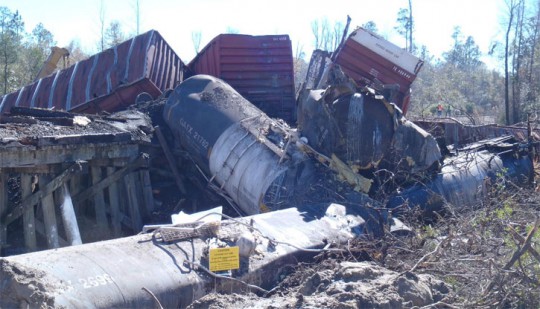
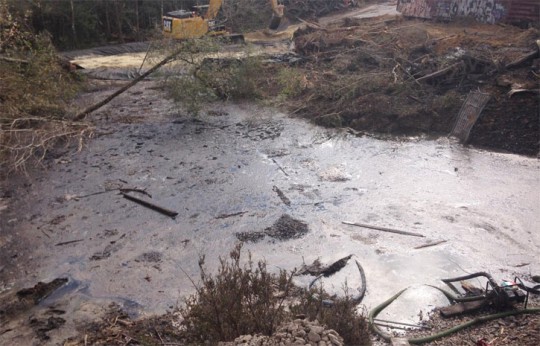
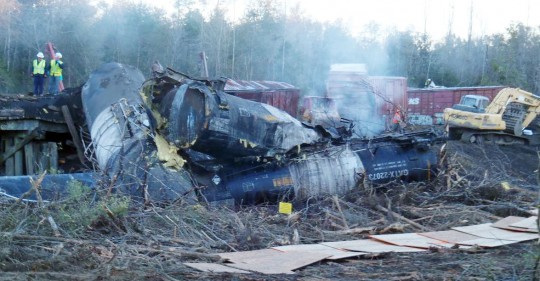
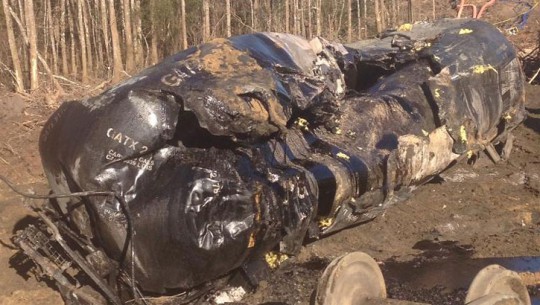
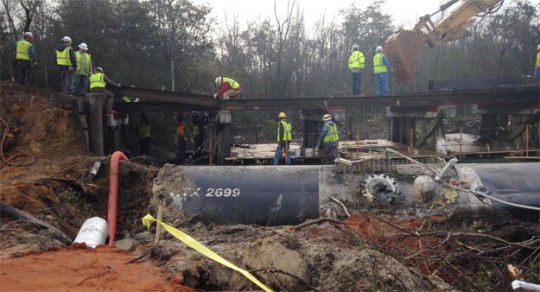
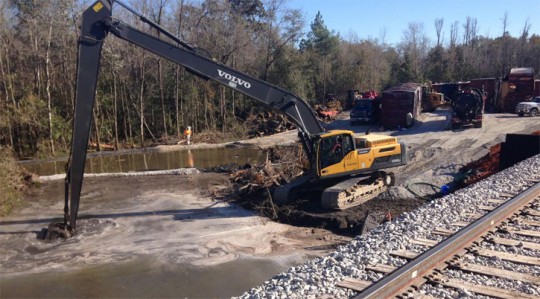
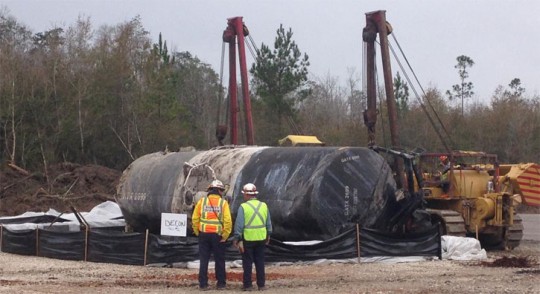
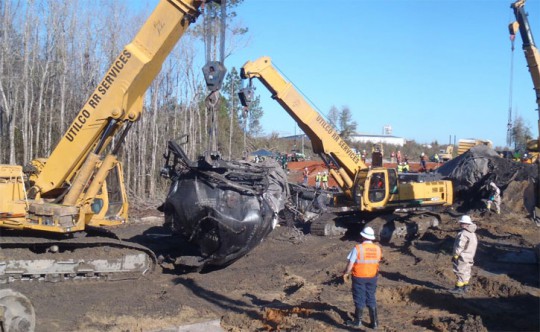
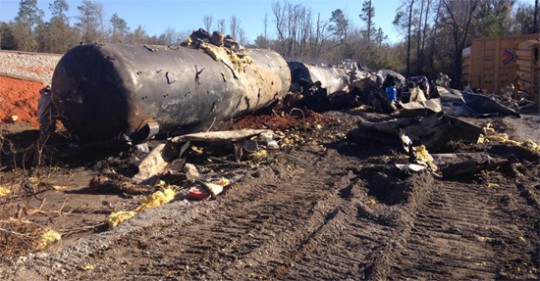
The cars aren’t melted or eaten up.
HazMat suits are worn if called for, indicating they aren’t called for.
Petroleum is not phosphoric acid.
Phosphoric acid is not petroleum.
I know one retired Exxon employee who was involved in the Exxon Valdiz spill cleanup way back then.
He never had any related problems and I doubt others did either.
Still … if it is fun to fear the unknown, enjoy.
BR549 says we should focus on the positives: that no one was hurt. Well clearly you don’t live in this area. I do. And everyone in my household, including all of our pets, were made sick by this incident. Furthermore, look at the photos for crying out loud! We are talking toxic corrosive acid that has apparently melted the cars carrying it — and NONE of the workers present are wearing hazmat suits?!? You can rest assured that those people were hurt and will likely have health problems popping up in the future. But what the hey… No BP oil spill cleanupers wore hazmat suits or protective gear, so are we really that surprised?? What happened to the Exxon cleanupers that didn’t wear hazmat/protective gear in Alaska in 1989? Oh that’s right… The majority of them are dead. You want to sit there and say no one was hurt, well… The truth is a lot of people were hurt by this disaster and will likely continue to hurt from it. What’s positive about that? Get real.
First of all, thanks so much for the wonderful follow up story with all the pictures. If I am looking at the photos correctly it looks as though the “small leak”, was really a catastrophic wreck of that tanker car. I understand other cars were above it, so I’m sure it was hard to get a good look, but if they could say that it was a “small leak from a valve on the bottom of the car” that seems as though they were able to see the valve, and wouldn’t they have seen at that point the gaping hole shown in the pictures. I have just had it with being misleaded to think that things are not as bad as they seem – I was taugh as a kid to fess up when I was wrong, and if I did not tell the whole truth I got a switch to the back of my legs or lost my privledges. Where is the accountability?
William,
I do
As best I recall, pH is the negative logarithm of the reciprocal of the hydronium ion concentration so ten to the point three would be something like twice as many hydronium ions per unit volume (off the top of my head, proper calculator being elsewhere).
Further, there are strong acids and weak acids with some being extremely harmful, others far less so. The phosphoric acid in most sodas will react with rust, releasing water and freeing rusted up nut/bolt combinations but it will not instantly eat your teeth out of your head. More concentrated will be more active just as ascetic acid will vigorously attack copper but in the dilute form of vinegar it must take much longer.
David for safe transportation
and salads
>>The pH of lemon juice is 2.3
Keep in mind that one full integer difference in the pH scale is 10 times more acidic.
The pH of lemon juice is 2.3
Still…
No leak to small leak to 30,000 gallons IS an interesting progression.
I assume the final limit is the entire volume of all the train’s capacity.
Any idea what the volumetric flow rate of the creek/branch is?
I live on River Bend and that same train was sitting waiting for another train to come by going southbound….I know that the train had sat there for a pretty long time before it moved to head north….It sat on the corner for a long time….once the south bound train had passed then a little later it started it’s way north….I don’t know about the ice but I would think the southbound train would have had problems with ice if this one did. However, it was sitting for a while so that could have been a contributor….just not sure…but just like the last derailment we may never truly know….
The only one that is respociable for the spill are the ones that wrecked. Just like BP, make the railroad pay for what they did.
“I have lived in this area almost 70 yrs. and that stream has always been called Fletcher branch not Fletcher creek.”
It’s Fletcher Creek according to all the maps and the government types.
I have lived in this area almost 70 yrs. and that stream has always been called Fletcher branch not Fletcher creek. Just saying
1st) Was this train JUST starting out or was it near it’s final destination? We don’t know so let’s not start bashing the engineer for being out on an icy tracks.
2nd) It doesn;t matter if the restocking of the stream is funded under any program since the railroad company is responsible for replacing everything damaged.
3rd) It certainly would be easier to replace the old bridges than to go through this but how do you replace ALL the thousands of miles of track that are very old without disrupting the flow of products from coast to coast and border to border?? It would be like working on a one lane highway. It is VERY unfortunate that we have to go through these types of issues but this is what happens when a nation is not happy with the simple things in life and just has to have more and more “stuff”.
Nobody wants this kind of thing to happen especially not the railroad company that has to pay out millions of dollars to clean it up and replace everything damaged including all of the severely damaged rail cars. The news papers and TV broadcasts can ONLY report the information they are provided with and nothing more. This was an accident, plain and simple, that could have been WAY worse than it was so instead of dwelling on the negative, look for the positives. Nobody got hurt.
Yall have a great day!
Jane—Ice on track rails is not the same as ice on roads or bridges. It would take many inches of ice to raise the wheels high enough to slip off a rail. The weight of the locomotive(s) would have crushed & destroyed any ice on the rails for the rail cars that followed behind. A quarter inch of ice or more would not affect a train. If there was a significant amount of ice, the locomotive drive wheels would have lacked the traction to move. It appears the tracks were in the area of a trestle that may have failed. If not, I suspect that a faulty rail or problem with a car wheel caused the derailment.
What concerns me is that they were telling us that it only had a small leak at the valve. With pH levels like that in the water they knew better. I am not blaming this news source because I am sure they were only reporting what they were told.
The trestle looks like it was built in the 1800’s. Multiple roads built to the site and dams. This area is ruined. The contaminated water is going to a “Water treatment site?” It would be interesting to know how they are going to treat that mess and what is going to happen to the tank cars that still have a lot of the acid in them. Didn’t the first reports of this say there were no leaks? Wouldn’t it be easier to fix our rails and bridges than to go though this?
The PH level for Battery Acid is 2.0
After the clean up perhaps Fish & Game can restock the stream.
Is that program still funded I wonder?
My question is why were they transporting dangerous chemicals during an ice storm when they knew the rails would have ice on them? If you can’t go out on the roads or even walk around outside easily, why would you think you could drive a train on icey tracks?